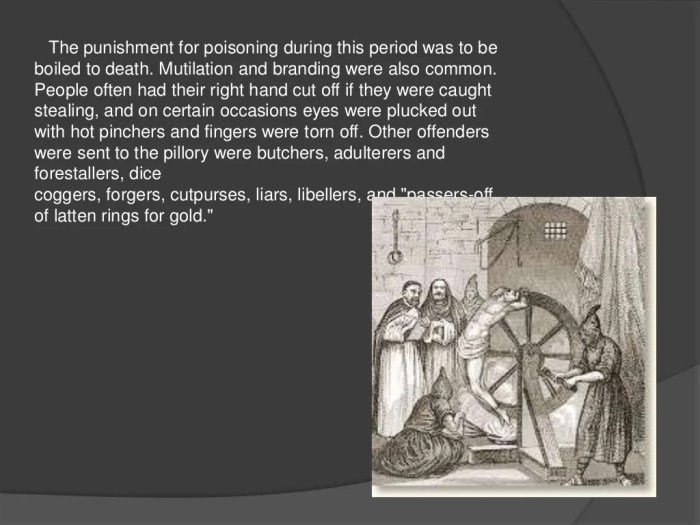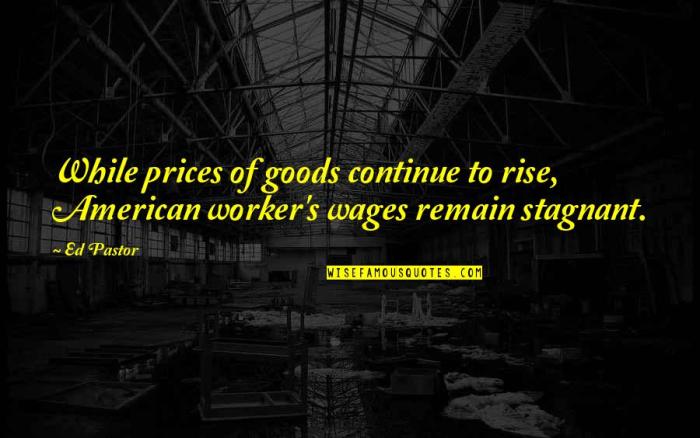Elizabethan era crime and punishment provides a fascinating glimpse into the social, legal, and moral attitudes of England during the late 16th and early 17th centuries. This era witnessed a significant rise in crime rates, leading to the implementation of harsh punishments that reflected the harsh realities of the time.
The Elizabethan era was a period of significant social and economic change, which contributed to the rise in crime. The growth of cities and the influx of rural migrants led to overcrowding and poverty, creating fertile ground for criminal activity.
Furthermore, the Protestant Reformation had weakened the authority of the Church, leading to a decline in moral standards and a decrease in the effectiveness of traditional forms of social control.
Elizabethan Era Crime

Crime was rampant in Elizabethan England, a period marked by social and economic upheaval. The influx of people to urban areas, the rise of a money-based economy, and the weakening of feudal ties all contributed to the increase in crime rates.
Common Crimes
The most common crimes during the Elizabethan era included:
- Theft: Petty theft was rampant, especially in crowded urban areas. More serious forms of theft, such as robbery and burglary, were also common.
- Violence: Violent crimes, including murder, assault, and rape, were relatively common. These crimes were often fueled by poverty, drunkenness, and the easy availability of weapons.
- Fraud: Fraudulent practices, such as counterfeiting, forgery, and cheating, were also common. These crimes were often perpetrated by individuals seeking to profit from the chaos of the era.
Contributing Factors
Several social and economic factors contributed to the high crime rates of the Elizabethan era:
- Rapid urbanization: The influx of people to urban areas created overcrowded and unsanitary conditions, which fostered crime.
- Economic inequality: The gap between the rich and the poor widened during the Elizabethan era, leading to resentment and social unrest.
- Weakening of feudal ties: The traditional feudal system, which had provided a sense of order and security, began to break down during the Elizabethan era. This led to a decline in social cohesion and an increase in crime.
Punishments
The punishments for crime in the Elizabethan era were harsh and often brutal. Common punishments included:
- Whipping: Whipping was a common punishment for petty crimes, such as theft and vagrancy.
- Imprisonment: Imprisonment was used for more serious crimes, such as robbery and murder. Prisons were often overcrowded and unsanitary, and many prisoners died from disease or malnutrition.
- Execution: Execution was the ultimate punishment for serious crimes, such as murder and treason. Executions were often public spectacles, and the bodies of executed criminals were often left on display as a warning to others.
Elizabethan Era Punishment

During the Elizabethan era, the English legal system was harsh and unforgiving. Punishments for even minor crimes were often severe, and the death penalty was frequently imposed. This harsh approach to punishment was based on the belief that crime was a sign of moral weakness and that criminals deserved to be punished severely in order to deter others from committing crimes.
Types of Punishments
The types of punishments used during the Elizabethan era varied depending on the severity of the crime. Some of the most common punishments included:
- Fines:Fines were a common punishment for minor crimes, such as theft or assault. The amount of the fine varied depending on the severity of the crime.
- Imprisonment:Imprisonment was another common punishment for minor crimes. Offenders were typically held in local jails, which were often overcrowded and unsanitary.
- Whipping:Whipping was a painful punishment that was often used for petty crimes, such as vagrancy or disorderly conduct. Offenders were typically whipped in public, which served as a deterrent to others.
- Branding:Branding was a permanent punishment that was used for more serious crimes, such as theft or robbery. Offenders were typically branded on the hand or face, which served as a mark of their crime.
- Mutilation:Mutilation was a severe punishment that was used for crimes such as treason or murder. Offenders were typically mutilated by having their hands or ears cut off.
- Death:The death penalty was the ultimate punishment for serious crimes, such as murder or treason. Offenders were typically hanged, drawn, and quartered, which was a particularly gruesome form of execution.
Rationale Behind Punishments
The harsh punishments used during the Elizabethan era were based on the belief that crime was a sign of moral weakness and that criminals deserved to be punished severely in order to deter others from committing crimes. This approach to punishment was also influenced by the religious beliefs of the time, which held that crime was a sin against God and that criminals should be punished accordingly.
Effectiveness of Punishments, Elizabethan era crime and punishment
The effectiveness of the harsh punishments used during the Elizabethan era is difficult to assess. There is no doubt that these punishments were severe, but there is no evidence to suggest that they were effective in deterring crime. In fact, some historians believe that the harsh punishments may have actually led to an increase in crime, as criminals became more desperate and willing to take risks.
Social and Legal Context of Crime and Punishment

The social and legal context of Elizabethan England greatly influenced the nature and severity of crime and punishment. The monarchy, church, and legal system played significant roles in shaping the justice system, while social class and gender also had a profound impact on the experience of crime and punishment.
The monarchy was the ultimate source of authority in Elizabethan England, and the king or queen had the power to make laws, pardon criminals, and dispense justice as they saw fit. The church also played a major role in the justice system, as it had its own courts and could impose punishments such as excommunication and penance.
The legal system was complex and often harsh, with a wide range of punishments available for even minor offenses.
Social Class and Gender
Social class and gender also had a significant impact on the experience of crime and punishment in Elizabethan England. The wealthy and powerful were more likely to escape punishment for their crimes, while the poor and marginalized were more likely to be severely punished.
Women were also more likely to be punished for crimes than men, even for the same offenses.
For example, a wealthy landowner who committed murder might be pardoned by the king, while a poor peasant who stole a loaf of bread might be hanged. Similarly, a woman who committed adultery might be burned at the stake, while a man who committed the same offense might only be fined.
Crime and Punishment in Literature and Art: Elizabethan Era Crime And Punishment

The Elizabethan era left a lasting legacy in literature and art, which vividly capture the attitudes and perspectives towards crime and punishment prevalent during that time. These artistic expressions not only reflect the harsh realities of the era but also shed light on the social, legal, and moral implications of criminal behavior.
One of the most striking features of Elizabethan literature is its preoccupation with crime and its consequences. William Shakespeare’s plays, for example, are replete with characters who engage in murder, theft, and other heinous crimes. In “Hamlet,” the titular character grapples with the moral implications of revenge after his father’s murder, while in “Macbeth,” the protagonist’s ambition leads him down a path of violence and tyranny.
Literary Works
Elizabethan literature provides a rich tapestry of perspectives on crime and punishment. Christopher Marlowe’s “The Jew of Malta” explores the themes of revenge and anti-Semitism, while Thomas Kyd’s “The Spanish Tragedy” delves into the psychological torment of a father seeking justice for his murdered son.
Artistic Representations
The Elizabethan era also witnessed a flourishing of artistic representations of crime and punishment. Paintings, engravings, and woodcuts often depicted scenes of public executions, gruesome tortures, and other forms of punishment. These images served as a stark reminder of the harsh consequences of criminal behavior and reinforced the authority of the state.
The Elizabethan era’s fascination with crime and punishment in literature and art reveals the profound impact of these issues on the society of the time. These artistic expressions provide invaluable insights into the social, legal, and moral values of the period, and continue to resonate with audiences today.
Key Questions Answered
What were the most common crimes committed during the Elizabethan era?
The most common crimes during the Elizabethan era were theft, assault, and murder. Theft was particularly prevalent due to the high levels of poverty and the lack of effective policing.
What were the punishments for crimes during the Elizabethan era?
Punishments for crimes during the Elizabethan era were harsh and often involved public humiliation, physical pain, or death. Common punishments included flogging, branding, and execution by hanging.
How did social class and gender affect the experience of crime and punishment in the Elizabethan era?
Social class and gender had a significant impact on the experience of crime and punishment in the Elizabethan era. The wealthy and powerful were more likely to escape punishment for their crimes, while the poor and marginalized were more likely to be subjected to harsh punishments.

